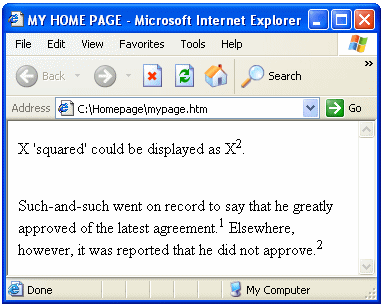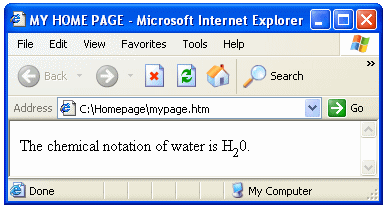Create a Web Page 101
Making Web Pages Intro
What is a Web Page?
Why Make a Web Page?
The History of HTML
Learn HTML or XHTML?
Basic HTML
Basic HTML Tutorials
Basic HTML Necessities
How to Make a Web Page
How to Edit a Web Page
The Basics of HTML Tags
Basic HTML Page Structure
HTML Attributes
HTML Font Codes
HTML Font Codes Intro
HTML Font Color Codes
HTML Font Size Codes
HTML Font Style Codes
HTML Bold/Italic Codes
Combining Font Codes
Formatting Text
Formatting Text Intro
Making Paragraphs
Miscellaneous Formatting
Headings & Subheadings
Creating Hyperlinks
Using Graphics
Using Graphics on the Web
Add Graphics to Your Pages
Graphics and Accessibility
How to Align Graphics
Page Color & Background
Graphics as Hyperlinks
Horizontal Rules
Creating Tables
HTML Tables Tutorials
HTML Table Fundamentals
Background & Border Color
Table Frames & Rules
Table Width and Alignment
Cells 1 -Space & Alignment
Cells 2 -Row Column Span
Cells 3 -Width & Height
Making Lists
HTML Frames
HTML Frames Tutorials
Using Frames for Layout
Advanced Frame Layouts
Putting Hyperlinks in Frames
Frame Border Width
Color, Margin and Control
Problems with Frames
SmartFrames: A Solution
SSI: An Alternative to Frames
Web Page Forms
Making Feedback Forms
A Simple Feedback Form
Installing NMS FormMail
Debugging Your Setup
My Web Host is Out to Lunch
User Input Components
Text Fields
Checkboxes & Radio Buttons
Dropdown Menus
Push Buttons
Layout and Presentation
Basic CSS
Basic CSS Tutorials
What is CSS?
Why You Should Use CSS
How to Use CSS
Inline Styles
Embedded Style Sheets
External Style Sheets
Class Selectors
ID Selectors
Combining Selectors
CSS Properties
CSS Properties Intro
Font Styles
Width, Height & Spacing
Borders
Backgrounds
Position
Float & Alignment
Hyperlinks
All About Web Hosting
Hosting Your Own Website
What is a Web Host?
Your Website's Home Page
Building a Website Offline
About Free Web Hosting
Best Free Web Hosting
Commercial Web Hosting
How to Get a Domain Name
Ecommerce Web Hosting
Web Hosting Terminology
Free Web Design Tools
Best Free Website Tools
Best Free Text Editors
Best Free Graphics Editors
Free Website Analysis Tools
Setting Up HTML Kit
HTML Kit Introduction
How to install HTML Kit
Screenshot Breakdown
Basic Configuration
Overall Appearance
Shortcuts and Startup
Editing Window
Customizing Toolbars
Using the Favorites Tab
Making a New Actions Bar
Odds and Ends
Free Templates
Free Website Templates
Two Column Fixed Width
Three Column Liquid Layout
Miscellaneous Templates
Dynamic Menu Effects
Two Column Experimental
Terms of Use
About These Templates
Website Templates Help
Getting Started
Template Zip File Download
How to Edit Your Template
What to Edit in the HTML
How to Add Your Logo
Making a Website
Web Design Tips
Web Design Basics
Tables vs. Tableless
Using Tables for Layout
Example Table Layouts
World's Crappiest Web Page
Twitter Backgrounds
Twitter Backgrounds Intro
Cool Twitter Backgrounds
Cool Twitter Backgrounds 2
Plain Twitter Backgrounds
Dark Twitter Backgrounds
Best Twitter Backgrounds
Cute Twitter Backgrounds
Music Twitter Backgrounds
Music Twitter Backgrounds 2
Twitter Backgrounds 101
TERMS OF USE
All About Web Browsers
What is a Web Browser?
Mozilla Firefox
Internet Explorer
Opera
How to Set Up Firefox
Top 5 Firefox Extensions
Contact
More HTML Font Styles - Bold/Italic Codes
<b>...</b> | Bold | (More details...) |
<i>...</i> | Italics | (More details...) |
<u>...</u> | Underline | (More details...) |
<s>...</s> | (More details...) | |
<tt>...</tt> | Teletype | (More details...) |
<sup>...</sup> | Superscript (E=MC2) | (More details...) |
<sub>...</sub> | Subscript (H20) | (More details...) |
font element and its attributes —face, size and color— there are a variety of other HTML font styles that you can use to format the text on your web page. These are listed in detail below along with example codes:- Bold ~ Using bold text will display your text in a thicker font making one or more words really stand out from the rest and will tend to draw the reader's attention to these words. This has a variety of applications and is largely a matter of taste. Bold text is sometimes used for list headers such as in this list of font styles. To create bold text, place the desired text within the
<b>...</b>tags.
Example:
<b>Your bold text goes here.</b>
- Italics ~ The italics font style slants the text to the right and thus can also be used to draw special attention to one or more words. You may wish to use italics instead of bold when the bold font style is too "loud" for your purposes. Italics has a variety of other applications and the use of it is largely a matter of taste. The italics are often formally applied to the titles of newspapers, magazines and books, such as when one wants to mention The New York Times. To display text in italics using HTML, place the desired text within the
<i>...</i>tags.
Example:
<i>Your italics text goes here.</i>
- Underline ~ Like bold and italics, underlining can also be used to place special emphasis on one or more words but this tends to have limited use on web pages since underlined text is also the default font style for hyperlinks. Seasoned internet users automatically assume that all underlined text constitutes a hyperlink. Thus, if you use underlining, be advised that some readers will be compelled to move their mouse pointer over your underlined text thinking it to be a hyperlink. Then, upon discovering that it's just text that you meant to emphasize, they may become miffed that you wasted their time and, worse, may ignore genuine hyperlinks that appear later on in the web page. Hence, for the purposes of clarity, underlined text should be avoided. Depending on the circumstances, however, this may not be an issue. To create underlined text, place the desired text within the
<u>...</u>tags.
Example:
<u>Your underlined text goes here.</u>
- Strike-through ~ Using HTML, you can create text that looks like it's been crossed out or appears like it has a line drawn through it. Formally this is used to indicate text that has been edited or changed but it also has some
funnycleverhumorous applications that might be worth exploring. To create strike-through text, place the desired text within the<strike>...</strike>tags or the<s>...</s>tags.
Example:
<strike>Your strike-through text goes here.</strike>
- Teletype ~ This kind of text style simulates the monospaced text created by a typewriter or teletype machine and is often used to denote HTML source code in reference files or tutorials such as this one. To create teletype text, place the desired text within the
<tt>...</tt>tags.
Example:
<tt>Your teletype text goes here.</tt>
The monospaced text style can also be produced using the<code>...</code>tags:
<code>Your code text goes here.</code>
- Superscript ~ Using HTML, you can create text that is raised above the preceding text and is displayed in a smaller font. This can be used for mathemetical considerations or it can be used to formally annotate compositions such as articles or essays. For example:

To create superscript text, place the desired text (typically a number) within the<sup>...</sup>tags.
Example:
Such-and-such went on record to say that he greatly approved of the latest agreement.<sup>1</sup>Elsewhere, however, it was reported that he did not approve.<sup>2</sup>
- Subscript ~ This kind of text is lowered below the baseline of the preceding text and is displayed in a smaller font. This can be used to display chemical notation:

To create subscript text, place the desired text within the<sub>...</sub>tags.
Example:
The chemical notation of water is H<sub>2</sub>0.
Now that you've become familiar with the HTML codes you can use to format text on your web page, you may be wondering how to properly combine font styles...
See also:
Best Free Stuff
for webmasters
for webmasters
Free Text Editors
Free Graphics Editors
Website Analysis Tools
Free Website Templates
See also:
If you need a .COM web address, you can get one quick and easy at...
| <~ BACK | TOP | NEXT ~> |